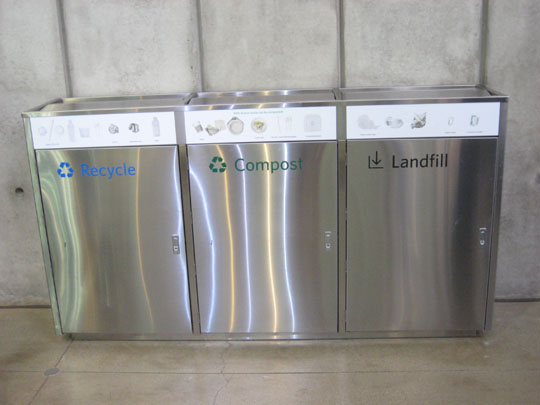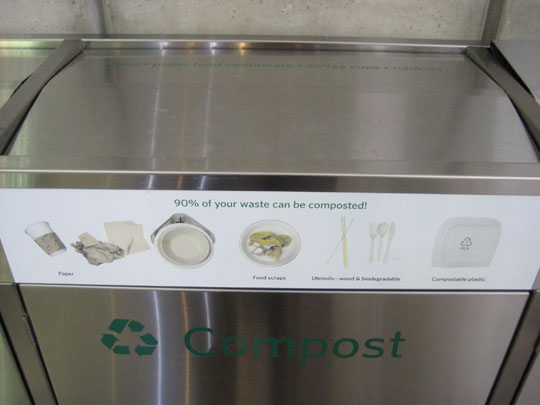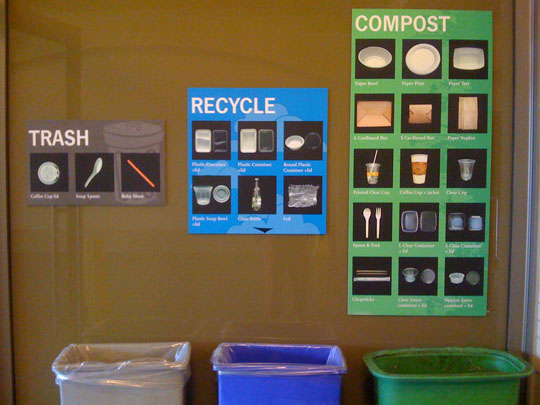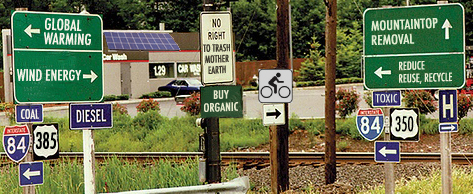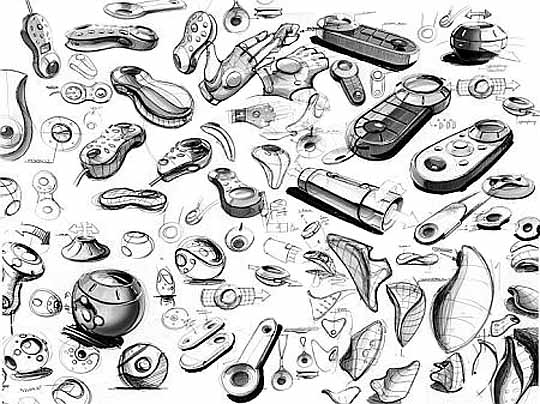Treat Yourself to a Green Business on Earth Day

In honor of the 40th anniversary of Earth Day, 4/22/10, GOforChange presents a greening business action list with a twist! We thought we’d do it a little differently, because our job is to help people understand not only what to do, but why. So often, the top-10 lists read like a shopping list. (This year, I’ve even seen 40-things lists!) The items may be categorized, but nothing is said about what it all means and why we would choose to do certain things.
Get ready, because our list starts with the Top Four Principles for a Green Business. To make it simple and concrete for you, each principle is paired with a specific business concern and four explicit green actions you can take. Think of it as a “tasting menu” to celebrate Earth Day. It’s like four carefully crafted courses, each paired with a beautiful wine. Each of the four courses has four delicious items on the plate for you to choose from – or you can really indulge and eat them all!
The four courses to taste today are the Four Principles for a Green Business:
- Appetizer: Aspire to be 100% good, not just “less bad”
- First Course: Act in cycles, rather than linear (waste = food)
- Second Course: Tap into an unlimited source of energy (the sun)
- Dessert: Attract and keep the best employees and customers (celebrate diversity)
The only way to make these real in your business is to taste them, to put them into practice. And, we’re going to show you how.
We paired four business concerns with each of the Four Principles. For each, the combination of flavors is subtle and unique: There are tastes that you avoid and tastes that you cultivate.
Appetizer: Policy & Practices that aspire to be 100% good, not just “less bad”
- Avoid: confusion, distraction, wheel-spinning, burn-out
- Cultivate: shared definitions and frameworks, creative teamwork
First Course: Handle materials in cycles, rather than lines (waste = food)
- Avoid: waste, toxics
- Cultivate: reuse, conservation, thoughtful purchasing
Second Course: Energy that taps into an unlimited source, the sun
- Avoid: waste, fossil fuel use
- Cultivate: savings, clean energy
Dessert: Workplace & Community that celebrates diversity, attracts and keeps the best employees and customers
- Avoid: isolation, competitiveness
- Cultivate: connection, flexibility, inclusiveness, creativity
So far, we’ve covered the why and the what – principles and specific business concerns. Now, for the how. I’m going to give you the four delicious tastes for each course on our menu. These are concrete action steps that will allow you to experience greening success in each area of your business.
Are you curious about the goodies in the appetizer course? Wait no longer! Here are four specific green actions can you take in your Policy & Practices:
- Write your green mission statement and set annual goals to move toward it.
- Establish green policies and practices. These will come in time, as you take more measures to go green. Be conscious to write them down, so you get systems in place that will outlast your current leadership.
- Measure, benchmark, and track progress regularly. This includes conducting audits of your energy and water use, and a waste audit.
- Regularly communicate your mission and progress on your website.
Hungry for more? It’s time for the First Course, Materials:
- Green your supply chain.
- Establish, revive, or enhance your recycling program.
- Avoid paper plates, foam or plastic cups, and plastic utensils in your kitchenette or break room. Instead, provide reusable cups, plates, and silverware.
- Have a no-bottled-water policy. Get a nice reusable dispenser to filter tap water and serve with reusable cups or glasses at your meetings. Some examples: Eco-Chic version from Aqua-Ovo. For us regular folk on the other end of the spectrum is the nice-looking polycarbonate model from Target.
By now, you are getting warmed up and ready for the Second Course, right? Good thing that’s all about Energy:
- Have a Smart Strip Blitz: Go around your office and plug everything into power strips and then turn off the strips with items that aren’t in use. Don’t forget that cell-phone charger! Then, sit back and count the money you’re saving.
- Find and use the Energy Star power management settings on your computer and monitor.
- Unless you’ve been time- or space-traveling lately, you’ve probably heard the suggestion to change all your incandescent lightbulbs to compact fluorescent. Here’s a twist on that: even if you’ve already changed over to CFL’s in the office, you can hold an employee CFL giveaway. Or, consider trying the new LED bulbs that save even more energy and last even longer. See what’s available at Home Depot:
- Energy efficiency isn’t just for offices. Your personal energy is a vital part of the picture. It is often closely associated with the metaphor of life as breath – the words ‘chi’, ‘prana’, and ‘spirit’, for instance, are all related in their respective languages to the verb ‘to breathe’. The advice here is: establish a daily energy recharge with conscious breathing. This can be very effective in the morning, combined with gentle stretching. Try using the Mindful Clock which chimes at defined intervals throughout the day, reminding you to stop and take a few deep breaths. You’ll be amazed at how energizing this simple practice is.
Did you skip to Dessert right away? Why not, eh? Life’s too short! To wrap up our delicious meal, we have four goodies for your Workplace & Community:
- Support local environmental / community groups, both financially and with volunteer time. Some great non-local ones: Earthshare and Kiva.
- Consider a telecommuting policy, ideally coupled with a program to encourage and/or reward use of public transit or bicycling.
- Hold regular Green Team meetings with broad participation and a focus on action and measurable results. (This is where your mission statement and goals from the Appetizer come in handy.)
- Provide or direct people to ongoing training in sustainable business topics. The Natural Step Network’s programs are a great resource.
We hope you enjoyed our Earth Day Tasting Menu! I know it was rich, and that you are likely feeling full and satisfied. (No food coma, though, right?) As always, we love your feedback. What’s working for you? Where are you encountering challenges?





 View the dynamic, moving GOforChange: Greening Baltimore video
View the dynamic, moving GOforChange: Greening Baltimore video
